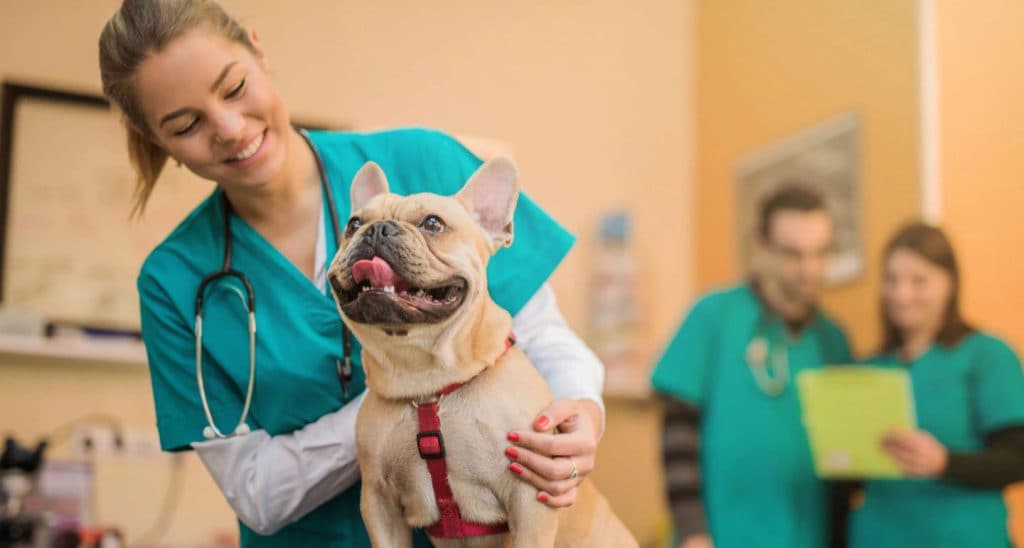Rabies is a fatal viral disease that can infect all mammals—including dogs, cats, and people—and is certainly not something you want to risk or mess around with. It’s transmitted to other animals via a bite or scratch, and kills tens of thousands of people every year worldwide.
While canine rabies has been mostly eradicated in the United States, an infected animal can still infect other dogs, cats, cattle, horses, people, and domestic animals. Making sure you get a rabies vaccine for dogs in your home is the best way to protect everyone—including your furry friends. Doing so also helps prevent the re-emergence of rabies
What is Rabies?
Rabies is a lethal condition that is caused by the Lyssavirus. It can infect all mammals, including humans. According to the Centers for Disease Control and Prevention, about 5,000 cases of rabies in animals are reported every year.
In the United States, five types of rabies are found in fox, raccoon, skunk, canine (coyote and dog), and bat populations. All five types are contagious to dogs and are almost always lethal once symptoms begin. Rabies is spread by bites from rabid animals through saliva or through the mucous membranes, and affects the nervous system, specifically.
The incubation period of rabies—which is how long it takes to show symptoms—is highly variable and depends on several factors. These include the age of the animal bitten, how far the bite is from the nervous system, and the dose of virus introduced to the body.
In most domestic species, the incubation period is generally between 3 to 8 weeks, but can be as short as nine days or as long as a year or more. The virus attacks and replicates in the nervous system, causing the clinical signs of rabies.
There are two forms of rabies: the excitatory form (sometimes call the “furious” stage) and the paralytic form (also referred to as the “dumb stage.”) Not all animals experience both stages, and symptoms can vary.
Symptoms may include:
- Vicious, erratic behavior (the classic form)
- Foaming at the mouth
- Heightened sensitivity to visual and auditory stimuli
- Weakness
- Paralysis
- Death from respiratory failure
Once symptoms appear, rabies generally results in death in 3 to 8 days. There is no treatment for rabies. The good news is this disease can be easily prevented via a rabies vaccine for dogs.
Does My Dog Need the Rabies Vaccine?
Absolutely! Part of responsible pet ownership is following local rules and regulations and doing what is best for the health of your pet. Making sure your dog is properly vaccinated for rabies is part of that process.
To that end, the rabies vaccine for dogs is the only vaccine required by law in most (but not all) states. If you are not sure if your city, state, or county requires a rabies shot for dogs, contact your local veterinarian for recommendations.
Dog Rabies Vaccine Schedule
While state and local requirements vary, the American Animal Hospital Association (AAHA) says that standard recommendations include administration of a single dose of killed rabies vaccine via injection under the skin or into the muscle to dogs no younger than 3 months of age.
Generally, puppies receive their first rabies vaccine between 12 to 16 weeks of age, which stimulates the immune system to make antibodies. A second single dose of rabies vaccine is administered one year later regardless of the age of the dog, and then every three years thereafter.
Dose #1 |
12 to 16 weeks |
Dose #2 (Booster) |
1 year after first dose |
Subsequent Boosters |
Every 3 years |
This canine vaccination schedule helps bolster your pup’s immunity against rabies in case they ever do end up exposed to this nasty virus. If a dog vaccinated with only one dose is ever exposed to rabies, the exposure to the virus serves as the second dose.
Download our Puppy Vaccinations Tracker printable, to help you keep track of your puppy's vaccinations.
How Much Does a Dog Rabies Vaccine Cost?
Fortunately, a rabies shot for dogs is easy to obtain, not too costly, and is deemed safe for your dog. Because rabies is a public health concern, the vaccine will be administered by a veterinarian after she or he has done a physical exam on your dog.
The cost of a veterinary exam usually runs from about $40 to $75, depending on the type of practice and your geographical area. The cost of a rabies vaccine for dogs typically ranges between $15 to $40 depending on your vet and where you live.
For cost-conscious pet parents who still want to protect their dog against infectious diseases, the price of vaccines can be reduced in several ways. There are many options available to get a low-cost rabies vaccine for dogs, including:
- Low-cost vaccine clinic at a pet store or feed store
- Low-cost vaccine clinic at a shelter
- Mobile/pop-up vaccine clinics
To find one of these clinics, Google “low-cost vaccine clinics” for your area or ask at your local pet store.
You can also ask your veterinary office if they run rabies vaccine specials, like on September 28, World Rabies Day. Other options include puppy packages that bundle and discount all puppy services (vaccines, de-worming, fecal exam, puppy exams, spay/neuter, microchip, etc.), or insurance/wellness plans that include vaccines.
Rabies Vaccine For Dogs Side Effects
The rabies vaccine for dogs has been around a long time and has a very low rate of severe adverse reactions. Though rare, some dogs may temporarily lose their hair at the vaccine site. Additional rabies vaccine for dogs side effects can include:
Mild Reactions
- Soreness at the site of injection
- Temporary fever
- Swelling where the injection was given
- Temporary tiredness and/or loss of appetite
Rare Reactions
- Hives, which look like firm bumps all over the body. May be itchy.
- Vomiting and/or diarrhea
- Swollen face, eyes, or muzzle
- Coughing
- Development of a tumor at the injection site (more of an issue in cats)
- Collapse or fainting
If you notice anything abnormal with your dog after he or she is vaccinated for rabies, contact your veterinarian. Even if you’re just concerned, it never hurts to call your vet and relay any symptoms they’re experiencing. For dogs that have severe reactions to vaccines, talk to your veterinarian about running antibody titers as an alternative.
Rabies Vaccine for Dogs FAQs
Q:
How long is the rabies vaccine for dogs good for?
The initial rabies vaccine is good for one year, and then additional boosters are required every 3 years.
Q:
Is the rabies vaccine for dogs necessary?
A:In the United States, rabies vaccination is required by law to license your dog in most counties. Check with your local governing authority to learn about rabies regulations in your area.
Q:
Can rabies shots make your dog sick?
A:As with all vaccines, some dogs can have adverse reactions after vaccinations, including soreness, swelling, hives, vomiting, diarrhea, and loss of appetite. If you notice anything more severe or abnormal after your dog is vaccinated, call your veterinarian.
Q:
Can a dog get rabies after vaccination?
A:No vaccine can prevent disease 100%, however, infection is rare in vaccinated dogs that have been exposed to rabies.
Hopefully, you will never be in a circumstance in which your dog is exposed to rabies, but it always pays to be prepared. Best of all, you’ll have peace of mind knowing that your dog is protected.
Share:









